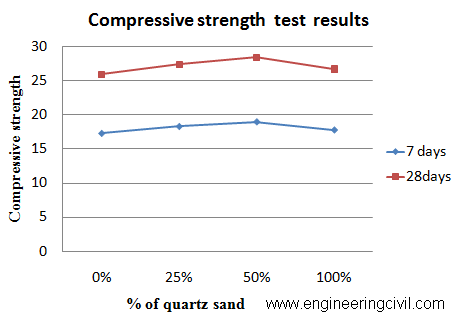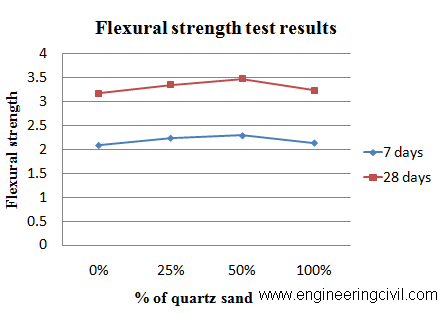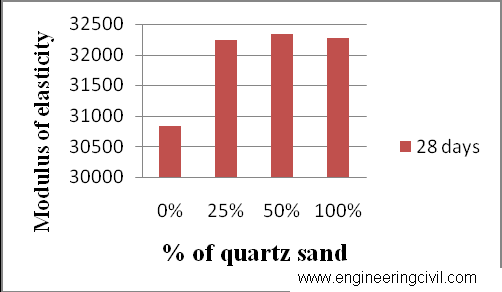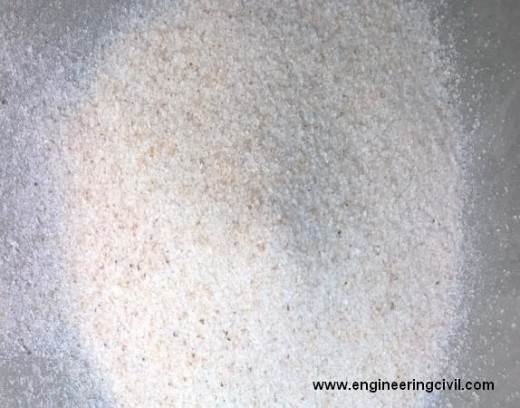BY
E.Divya1 , R.Shanthini2, S.Arulkumaran3
Student, Dept. of civil engg., IFET college of engg., India1, 2
Asst. professor, Dept. of civil engg., IFET college of engg., India3
ABSTRACT
The use of quartz sand as replacement for sand is an economical solution for making the concrete resistant to weathering. The paper presents a concrete mix design procedure for partial replacement of sand with quartz sand. Present method was performed to evaluate the additional compressive, flexural strength with higher slump over conventional concrete in which sand is replaced with 0%, 25%, 50% and 100% of quartz sand by weight with 1% super plasticizers. The research also revealed that there is possibility of replacing fine aggregate with quartz sand in the production of structural concrete. The mix proportion adopted was 1:1.7:3 as per 10262:2009. Compressive and flexural strength tests were carried out to evaluate the strength properties of concrete at the age of 7 and 28 days. Modulus of elasticity tests were carried out at the age of 28 days.
1. INTRODUCTION
Quartz is the most abundant silica mineral. Pure Quartz is colourless and transparent. It occurs in most igneous and practically all metamorphic and sedimentary rocks. Quartz is mainly made up of silica. The formula for it is SiO2. It has a hardness of 7 on the Mohs scale. It is highly resistant to both mechanical and chemical weathering. This durability makes it the dominant mineral of mountaintops and the primary constituent of beach, river and desert sand. Quartz is ubiquitous, plentiful and durable.
Sand becomes a scarce material, alternative for sand is needed all over, and also providing good strength than conventional concrete and some additional advantages, this experiment is done. This study gives a new alternative for fine aggregate. Resistant nature to weathering is very useful for buildings in future.
Quartz sands are used for traction in the railroad and mining industries. These sands are also used in recreation on golf courses, volleyball courts, baseball fields, children’s sand boxes and beaches.
It is also used in glass manufacturing, petroleum industry, as an abrasive. Quartz sand is used as filler in the manufacture of rubber, paint and putty. Quartz is very resistant to both chemicals and heat. It is used as a foundry sand with a melting temperature higher than most metals. Refractory brick are often made of quartz sand because of its high heat resistance.
1.1 OBJECTIVES
• Sand becomes a scarce material, alternative for sand is needed all over, and also providing good strength than conventional concrete and some additional advantages, this experiment is done.
• Compare the strength properties of conventional concrete mix M20 with the properties of concrete with quartz sand partially replacing sand.
• Find the optimum percentage of quartz sand that can be replaced for sand.
1.2 SCOPE OF THE PROJECT
• Make use of the quartz sand available from industries and also the river side in the form of deposits as fine aggregate in concrete.
• Evaluate the properties of fresh concrete and strength properties of hardened concrete.
• This study gives a new alternative for fine aggregate. Resistant nature to weathering is very useful for buildings in future.
2. EXPERIMENTAL PROGRAMME
The Experimental Program was designed to investigate the effect on the properties of the concrete by using quartz sand as a partial replacement for fine aggregate with different proportions 0%, 25%, 50%, 100%.For each test at each curing age, and the average values were used for analysis.
3. MIX PROPORTION:
| QUARTZ SAND | FINE AGGREGATE |
| 0% | 100% |
| 25% | 75% |
| 50% | 50% |
| 100% | 0% |
4. SELECTION OF MATERIALS AND ITS PROPERTIES
4.1 MATERIALS
4.1.1 Cement
It can be defined as material having adhesive and cohesive properties which make it capable of binding material fragments in to a compact mass. Cement is obtained by burning together in a definite proportion, a mixture of naturally occurring calcareous (containing calcium carbonate or lime) and argillaceous (containing alumina) material to be partial fusion at high temperature about 1450oC. The four major compounds are:
- Tricalcium silicate (3CaO.SiO2)
- Dicalcium silicate (2CaO.SiO2)
- Tricalcium aluminate (3CaO.Al2O3)
- Tetracalcium aluminoferrite (4CaO. Al2O3.Fe2O)
The ordinary Portland cement was classified in to three grades, namely 33grades, 43 grades and 53 grades depending upon the strength of the cement at 28 days when tested as per IS 4031-1988. If 28 days strength is not less than 53N/mm2, it is called 53 grade cement. It is proposed to study the properties of high strength concrete of grade M20. Adopting 53 grade cement for the study.
4.1.2 Fine Aggregate
Aggregates provide dimensional stability and wear resistance for concrete. Not only do they provide strength and durability to concrete, but they also influence the mechanical and physical properties of concrete. Aggregates act as a filler material and lower the cost of concrete. Aggregates should be hard, strong, free from undesirable impurities and chemically stable. They should not interfere with the cement or any of the materials incorporated into concrete. They should be free from impurities and organic matters which may affect the hydration process of cement. The workability, strength, durability and moisture susceptibility of concrete are greatly influenced by the characteristics ofaggregates. Fine aggregate (sand) is defined as an aggregate with particles of size smaller than 4.75mm and equal to or larger than 75µm.Natural River sand with fraction passing through 4.75mm sieve and retained on 60micron sieve will be used.
4.1.3 Coarse Aggregate
Coarse aggregate consists of rounded river gravel, crushed stone or manufactured aggregate with particles of size equal to or larger than 4.75mm.Coarse aggregate of size 20mm has been selected for the study. The physical properties will be tested as per IS2386 (part 1)-1963.It is used to improve the strength of the concrete.
4.1.4 Water
Water is needed for the hydration of cement and to provide workability during mixing and for placing. Portable tap water available in the laboratory with pH value of 7.0 and conforming to the requirements of IS456-2000 is used for making concrete and curing the specimen as well.
4.1.5 Super plasticizer
Super plasticizer is the highly water reducing chemical admixture which helps in retaining the flowing properties of a concrete mixture. They are used to modify the physical properties of the concrete mixture. It is used for other purpose like saving the mechanical energy.
4.1.6 Quartz sand
Quartz is the most important sand-forming mineral. Because it is resistant to both physical and chemical weathering and it is also physically hard. Quartz sand can be found in Florida and passive continental margins. Sand from Siesta Key beach is sometimes called the whitest in the world although it has competitors. Thus, we very often see it in sediments. Quartz is also the most important hydrothermal mineral, filling cracks in the crust with many other and often economically important minerals.
4.2 PROPERTIES
4.2.1 Properties of Quartz sand
Specific gravity = 2.45
Water absorption = 1.98%
Fineness modulus = 4.2
4.2.2 Properties of fine and coarse aggregate
Specific gravity of fine aggregate = 2.5
Specific gravity of coarse aggregate = 2.6
Water absorption for fine aggregate = 1%
Water absorption for coarse aggregate = 0.6%
Fineness Modulus of fine aggregate = 4
Fineness Modulus of coarse aggregate = 5.94
Specific gravity of cement = 3.1
These the values obtained from preliminary tests conducted.
5.RESULTS AND DISCUSSIONS
5.1 Results of Compressive Strength Tests on Concrete Cubes
The specimens are tested to find out the mechanical properties. The concrete cube specimens were placed over the Compression Testing Machine and the load was gradually applied till the failure of the specimen. The ultimate load was noted down as collapse load and compressive strength was calculated. The results of the compressive strength tests on concrete cubes are shown in Table1 and Graph1.
Table 1: Compressive Strength of Concrete Cubes with various percentages of Quartz sand
| Quartz sand replacement | Compressive Strength (N/mm2) | |
| % | 7 days | 28 days |
| 0% | 17.29 | 25.9 |
| 25% | 18.27 | 27.4 |
| 50% | 18.93 | 28.4 |
| 100% | 17.78 | 26.7 |

Graph 1: Compressive Strength of Concrete Cubes with various percentages of Quartz sand
The results of the compressive strength of concrete cubes show that the compressive strengths reduced as the percentage Quartz sand increased. However, the compressive strengths increased as the number of days of curing increased for each percentage Quartz sand replacement. It is seen from Table 1 that for the control cube, the compressive strength increased from 17.29 N/mm2 at 7 days to 25.9 N/mm2 at 28 days.
After replacing 50% of quartz sand replacement the compressive strength increased from 18.93 N/mm2 to 28.4 N/mm2.This is the optimum strength value of compressive strength.
5.2 Results of Flexural Strength Tests on Concrete beams
Flexural strength also known as modulus of rupture, bend strength or fracture strength, a mechanical parameter for brittle material, is defined as a material’s ability to resist deformation under load.
The results of the Flexural Strength tests on concrete beams are shown in Table2 and Graph 2
Table 2: Flexural Strength of Concrete beams with various percentages of Quartz sand
| Quartz sand replacement | Flexural Strength (N/mm2) | |
| % | 7 days | 28 days |
| 0% | 2.1 | 3.18 |
| 25% | 2.25 | 3.36 |
| 50% | 2.3 | 3.48 |
| 100% | 2.15 | 3.24 |

Graph 2: Flexural Strength of Concrete beams with various percentages of Quartz sand
The results of the Flexural strength of concrete beams show that the Flexural strengths reduced as the percentage Quartz sand increased. However, the Flexural strengths increased as the number of days of curing increased for each percentage Quartz sand replacement. It is seen from Table 2 that for the control beam, the Flexural strength increased from 2.1 N/mm2 at 7 days to 3.18 N/mm2 at 28 days. At the 50% replacement of quartz sand, the flexural strength increased from 2.3 N/mm2 to 3.48 N/mm2.At that percentage the optimum flexural strength is obtained.
5.3 Results of Modulus of elasticity Tests on Concrete cylinders
The test specimens as per IS: 516· 1959 (15mm diameter and 300mm height). The specimens are placed, with the strain-measuring system attached in the testing machine making certain that the load transfer system is properly aligned. Zero the strain indicators. Apply the tensile load continuously and without shock as prescribed in CRD-C 164. Record, without interruption of loading, the applied load and axial strain. Axial strain is defined as the total axial deformation divided by the effective gage length.
Calculate the modulus of elasticity using formula:
E = (S2 – S1)/ (€2-€1)
E = modulus of elasticity
S2 = stress corresponding to 50 percent of ultimate load,
S1 = stress corresponding to 10 percent of ultimate load,
€2 = longitudinal strain produced by S2
€1= longitudinal strain produced by S1
| % OF QUARTZ SAND | YOUNG’S MODULUS |
| 0 | 30827.15 |
| 25 | 32243.07 |
| 50 | 32332.12 |
| 100 | 32275.38 |
Table 2: Young’s modulus of Concrete cylinders with various percentages of Quartz sand

Graph 3: Young’s modulus of Concrete cylinders with various percentages of Quartz sand
6. CONCLUSION
Based on experimental research for concrete made with partial replacement of fine aggregate by quartz sand with different percentage (0%,25%,50% and 100%) are conducted, the test results show clearly that 50%quartz sand as a partial replacement of fine aggregate has beneficial effects of the mechanical properties concrete & the following conclusions are drawn at 28 days.
- Compressive strength is 9.53% greater than that of Conventional concrete
- Flexural strength is 13.53% higher than that of Conventional concrete
- Modulus of elasticity is 4.88% higher than that of Conventional concrete.
- The water absorption was about 0.31%less than that of conventional concrete.
7. REFERENCE
[1] Tarun R. Naik, Viral M. Patel, Dhaval M. Parikh, Mathew P. Tharaniyil, “Utilisation of used foundry sand in concrete”, Journal of Materials in Civil Engineering, Vol. 6, No. 2, May, 1994.
[2] Foundry Industry Recycling Starts Today (FIRST), Foundry Sand Facts for Civil Engineers, Federal Highway Administration Environmental Protection Agency Washington, DC; 2004.
[3] Han-Young Moon, Yun-Wang Choi, Youg-Kyu Song and Jung-KyuJeon, “Fundamental properties of Mortar and Concrete using waste foundry sand”, Journal of the Korea Concrete Institute, Vol.17, No.1, pp.141-147, February 2005.
[4] RafatSiddique, Geert de Schutter, Albert Noumowe, “Effect of used-foundry sand on the mechanical properties of concrete”, Elsevier, Construction and Building Materials 23 (2009) 976–980.
[5] SaveriaMonosi, Daniela Sani and Francesca Tittarelli, “Used foundry sand in cement mortars and concrete production”, The Open Waste Management Journal, Vol.3, ISSN 1876-4002, pg.18-25, 2010.
[6] J. M. Khatib, S. Baig, A Bougara and C Booth, “Foundry sand utilization in concrete production”, Second International Conference on Sustainable Construction Materials and Technologies, ISBN 978-1-4507-1490-7, June 28-30, 2010.
[7] Khatib.J.M, Baig.B, Menadi.B, Kenai.S, “Waste foundry sand usage in concrete”, INVACO2, Morocco-Rabat, November 23-25, 2011.
[8] Kumbhar P. D. and Usharani S. Sangar, “Experimental study of mechanical properties of concrete blended with used foundry sand”, Global Journal Engineering and Applied Sciences, ISSN 2249-2631, Pg.122-126, 2011.
[9] RafatSiddique, YogeshAggarwal, ParatibhaAggarwal, El-HadjKadri, RachidBennacer, “Strength, durability, and micro-structural properties of concrete made with usedfoundry sand (UFS)”, Elsevier, Construction and Building Materials 25 (2011) 1916–1925.
[10] S. L. Bradshaw, C. H. Benson, E. H. Olenbush J. S. Melton, “Using foundry sand in green infrastructure construction”, Green Streets and Highways 2010, ASCE 2011.
[11] W.R. L Da Silva, E.Tochetto, L.R. Prudencio Jr., A.L. Oliveira, “Influence of foundry sand residues on the fresh and hardened properties of mortars produced with Portland cement”, Ibracon Structures and Materials Journal, ISSN 1983-4195, Volume 4, Number 4 (October, 2011), p. 642- 662.
[12] Gurpreet Singh, Rafat Siddique, “Effect of waste foundry sand (WFS) as partial replacement of sand on the strength, ultrasonic pulse velocity and permeability of concrete”, Elsevier, Construction and Building Materials 26 (2012) 416–422.
[13] Gurpreet Singh, Rafat Siddique, “Abrasion resistance and strength properties of concrete containing waste foundry sand (WFS)”, Elsevier, Construction and Building Materials 28 (2012) 421–426.
[14] H. MerveBasar, NuranDeveciAksoy, “The effect of waste foundry sand (WFS) as partial replacement of sand on the mechanical, leaching and micro-structural characteristics of ready- mixed concrete”, Elsevier, Construction and Building Materials 35 (2012) 508–515.
[15] Johnny Bolden, Taher Abu-Lebdeh and Ellie Fini, “Utilization of recycled and waste materials in various construction applications”, American Journal of Environmental Science, 9 (1), ISSN: 1553-345X, Pg.14-24, 2013.
[16] J.M. Khatib, B.A. Herki, S. Kenai, “Capillarity of concrete incorporating waste foundry sand”, Elsevier, Construction and Building Materials 47 (2013) 867-871.
We are thankful to E.Divya for submitting this research paper to us. We are hopeful that this will be of great use to all engineers who are looking for more information on “Behaviour Of Concrete Partially Replacing Quartz Sand As Fine Aggregate.“
If you have a query, you can ask a question here.



